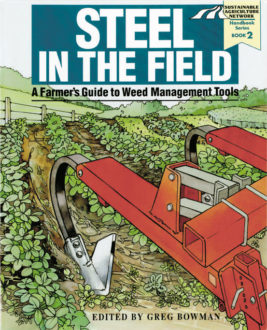Agronomic Row Crops: The Farmers
Single-Sweep Shines in Georgia Cotton
Nelson Hattaway
Blakely, Georgia
- 1,500 acres cotton
- 700 acres peanuts
- oats as cover crop
- strip tillage
Weed management highlights
Strategies: Banding in-row herbicides... cultivators for escape weeds in row middles... winter cover crops full-rate herbicides
Tools: single-sweep, maximum-residue cultivator... low-residue cultivator
Mechanical cultivation never went out of style in southwest Georgia, but a surge of interest in single-sweep, heavy-duty cultivators followed the advent of no-till cotton in the early '90s.
'Even where I haven't got much residue, my Buffalo 6300 keeps straight going down the row,' says Nelson Hattaway. The high-residue cultivator's rigid single sweeps travel through in his hard, red clay soils better than his S-tine multi-sweep. He uses the older unit, however, for repeat passes in severe weed infestations, and for herbicide banding. It's equipped with a gauge wheel for each gang of three sweeps.
The heavy-duty Buffalo cultivator with its residue-cutting coulter earns its pay, especially in slicing easily through heavy debris and patches of nutgrass that used to plug Hattaway's rolling cultivator. 'The single no-till sweep basically takes care of anything in its path,' he's found after two years of using it. He reports his units (he bought a second eight-row a year after the first one) work effectively without plugging, even in wet soils.
Hattaway runs 24-inch, single-piece sweeps between rows that are 36 inches apart. He runs disk hillers to within 6 inches of the row on his first pass in cotton and within 4 inches of peanuts. He keeps flat-panel crop shields on for all cultivations to prevent loose soil from interfering with herbicide in the crop rows (called the 'drill' in cotton country). His challenging weeds include morning-glory species, nutsedge, buffalo grass, coffee weed and sand bur.
Hattaway fall-plants oats - at 2 bushels per acre, drilled in 7-inch rows, then harrowed lightly - to protect his soil and keep down winter weeds. He chemically burns down the cover crop when it's 6 to 10 inches tall. This is usually late March or early April, about a month before he strip-till plants cotton. He uses a six-row KMC no-till planter with residue-cutting coulters, heavy subsoiler shanks, fluted coulters, row-openers, gauge wheels and a soil crumbler roller ahead of a seeder unit. Seed is placed in a tilled, firmed and leveled 8- to 12-inch strip. (See Kelley Mfg. Co. in 'Tool Sources' section.)
Hattaway bands a grass and broadleaf herbicide mixture over the foot-wide tilled strip at planting and broadcasts a second mix postemergence. He's still improving parts of the system but observes that it works best under irrigation so he can be sure to stimulate seeds and activate herbicides.
While hand-hoeing weeds is seldom done in his area, Hattaway wants to learn more about in-row mechanical weeding tools. 'If it kills weeds,' he admits, 'I'm open to about anything."
